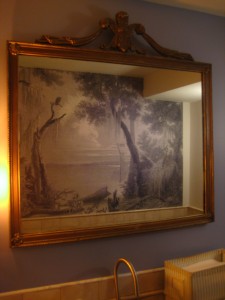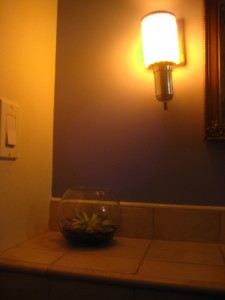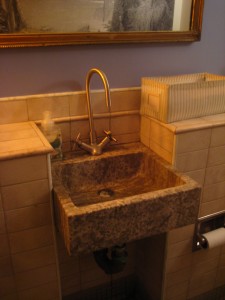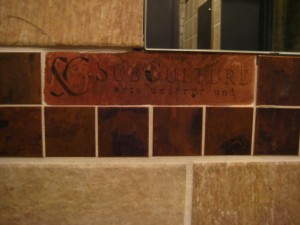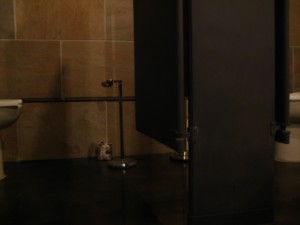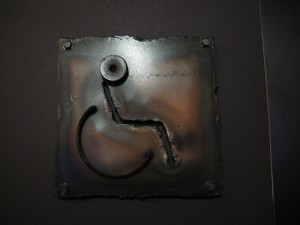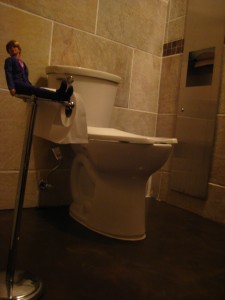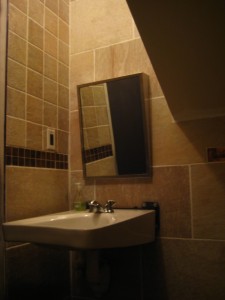Bowery Poetry Club
Posted: October 14, 2014 Filed under: NoHo | Tags: TUESDAY TOILET TALK Comments Off on Bowery Poetry ClubThough the Bowery Poetry Club was just one block removed from a venue that hosted the New Yorker Festival this past weekend, it appeared to be a world away judging from the audience members. Of the dozen plus people lined up to see singer Somi when I arrived, everyone was black except for two white patrons. It provided a stark contrast to the demographics of the New Yorker Festival-goers, in which I spotted just one or two black patrons in a crowd of one to two hundred people for eight events in a row. When I saw four black people walk in for the last and ninth festival event, I knew that one of the speakers that would be on stage had to be black.
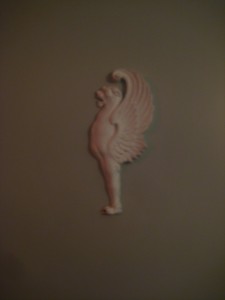 “I can’t tell with these gargoyles,” said a lady also looking for the restroom at the Bowery Poetry Club. It took me a moment to determine that each of the three doors at the bottom of the stairs led to an individual unisex bathroom. The gargoyle-like creature mounted on each door gave no indication that patrons were welcome in there but it did suit the fanciful decor of the venue. Their main entrance is ambiguous as well, marked “Duane Park” on the door.
“I can’t tell with these gargoyles,” said a lady also looking for the restroom at the Bowery Poetry Club. It took me a moment to determine that each of the three doors at the bottom of the stairs led to an individual unisex bathroom. The gargoyle-like creature mounted on each door gave no indication that patrons were welcome in there but it did suit the fanciful decor of the venue. Their main entrance is ambiguous as well, marked “Duane Park” on the door.
Run by the nonprofit Bowery Arts+Science, Bowery Poetry hosts many poetry events as the club name suggests. I rarely go to hear poetry so it’s no surprise that I was unfamiliar with the venue. Considering that Manhattan is merely thirty square miles with over one and a half million people squished inside the island, there is minimal mingling among inhabitants. While class and race goes without saying, the ghettos can also be defined by niche artistic disciplines and fields.
The bathrooms had pleasant ambient lighting and plants which may or may not have been fake. The middle bathroom (pictured) that had space on either side of the toilet felt more spacious than the room to the left that had the toilet installed close to the wall on one side. There were no Halloween decorations in the bathrooms even though fake spiders and decorative skulls lined the railings and walls in the rest of the venue.
The over-sized spiders were distasteful to my coworker but the life-size sketches of the interior painted on the wall behind the small stage and the staircase from which the ensemble descended were delightful. The ensemble included Liberty Ellman (guitar), Toru Dodo (piano), Otis Brown III (drums), Keith Witty (bass), and a violinist and cellist I didn’t catch the names of backing Somi on her project The Lagos Music Salon. The audience swooned at the sight of the singer and gathered around her for selfies and autographs after the show, effectively blocking my exit as I tried to squeeze my way out between the tables.
Somi presented her connection to Lagos, her East-African roots and her American-ness in an authentic way, making concrete the smallness and enormity of the world at once. My friend and college student Derek from Hong Kong tells us in his native Cantonese how to ask the question raised all over the world —
Ching man dim yeung hui qi sor?
Subculture
Posted: June 11, 2013 Filed under: NoHo | Tags: TUESDAY TOILET TALK Comments Off on Subculture“How’s everyone doing—is everyone holding their water? When there’s a long set, sometimes people need a pee break.” Ever the thoughtful one, bandleader Laila Biali surveyed the audience an hour into the last Friday night of her May residency at Subculture, a venue in its debut month. Pressing down on the piano pedals barefoot, she displayed equal freedom in her voice as she sang, joined by drummer Ben Wittman, electric bassist Chris Tarry and violinist Zach Brock.
Downstairs from the Culture Club, the new venue differs from most other jazz-presenting places in the city in that it appears spacious, clean and well-ventilated, despite its subterranean setting. The chairs set up in rows make Subculture feel like a casual small auditorium, laid-back with its industrial, urban interior design. Rather than showcase its name on the stage backdrop, the club drilled a huge sign onto the wall behind the bar, visible immediately upon entering the room.
I also noticed the name engraved into a tile lining the wall of the ladies room, along with tiles holding carefully considered images to match the overall design. The restroom is between the wheelchair accessible and men’s room in the back corner by the bar. Strangely, the door marked with a sign of a stick figure in a wheelchair had little behind it that made it distinctly accessible. It lacked the requisite grab bars, among other necessities. Essentially, it was a nice bathroom for one, instead of with two stalls and sinks like the shared women’s room.
Having just returned from a trip home to beautiful and comfortable Los Angeles, I was in a sulk about being back in this humid and congested city. Seeing that it was a pleasant night out, I decided to walk up a subway stop or two after Laila’s show. On my stroll through Greenwich Village, I ran into a couple guys who were headed to Blue Note to see one of our friends play. Another musician friend then ran into us, on his way to catch the train to Jazz Standard from the Bar Next Door. This happens in LA … never.
I’ll remember why I love New York on the days when I’m walking up to my tiny place, having to step skillfully between a giant cockroach and a condom on the stairs. Seydina from Senegal tells us how to say, “Where’s the restroom?” in his mother tongue, Wolof –

